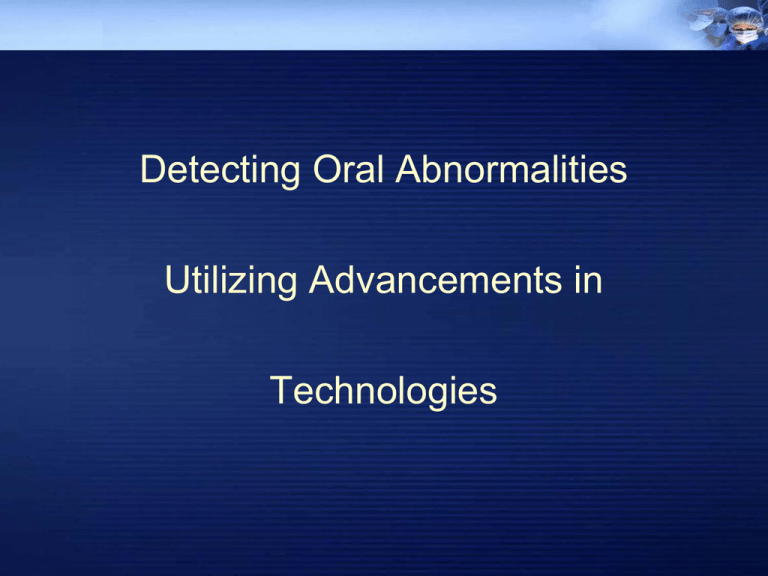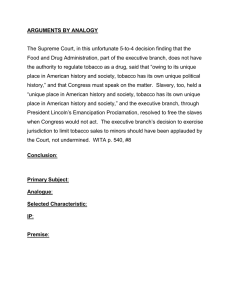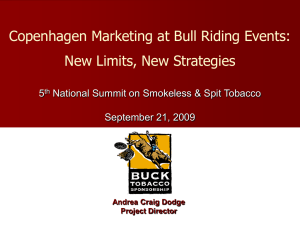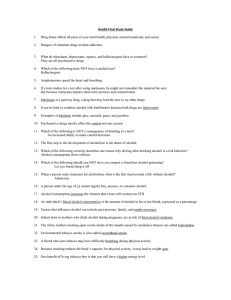Detecting Oral Abnormalities Utilizing Advancements in Technologies
advertisement

Detecting Oral Abnormalities Utilizing Advancements in Technologies Presented By: Leslie Gilchrist Calandra Portalatin Brigitta Nuccio Big Bend Area Health Education Center, Tallahassee, FL West Florida Area Health Education Center, Crestview, FL Support Oral Cancer Awareness www.OralCancerFoundation.org Oral Cancer - Basic Facts The Reality of Oral Cancer… • One person dies every hour of every day of Oral Cancer • Oral Cancer - 9th highest death rate among all 32 categories of cancer • The mortality rate in the U.S. is higher than that of cancers which we hear about routinely such as breast, cervical, Hodgkin's, prostate, liver, testes, kidney, thyroid and colon – National Cancer Institute/SEER Report • 2007 and 2008 - incidence Oral Cancer increased over 11% in the U.S. –One of few cancers actually increasing each year • At 11% growth rate - 87,961 patients will die over the next 5 years Oral Cancer – Patient Education Know 2 Important Statistics National Cancer Institute – SEER reports (Surveillance Epidemiology and End Results) All 32 measurable forms of cancer Oral Cancer – Patient Education Oral Cancer – Patient Education Oral Cancer – Research Data True or False… The majority of patients referred to an Oral Surgeon or ENT for suspected oral cancer biopsy, are referred by a dental health provider Oral Cancer – Research Data False… In 2008, Primary Care Physicians referred 310,000 patients with abnormal oral tissue lesions to Oral Surgeons or ENT Dentists referred 220,000 Oral Cancer – Research Data I Don’t Believe It! “My Family Doctor looks in my mouth for maybe three seconds… how can they be finding the majority of oral cancer?” -Industry Professional Oral Cancer – Research Data They’re not… most patients are finding it themselves! Patients go to their Primary Care Physicians for sore throats and cold sores. 62% of Oral Cancer is found by the patient in stage 3 or 4 Oral Cancer – Research Data Patients think dentists are about teeth! A very small percentage of patients understand that annual check-ups are about more than cavities and cleanings According to the ADA only 15% of patients report any knowledge of having an oral cancer screening Oral Cancer - Basic Facts What Patients Need to Know… Dentists and Hygienists are in the best position to be front line detectors for early stage Oral Cancer Oral cancer can frequently prosper without producing pain or symptoms the average patient might recognize Oral Cancer - Basic Facts Late Stage Discovery can be very costly… As a result there is a high risk of producing second, primary tumors before the first tumor is ever detected Oral Cancer often goes undetected until it has already metastasized to another location. Oral Cancer - Basic Facts For those who do survive late stage discovery … Life may never be the same Oral Cancer - Basic Facts The Good News… When found early, oral cancer patients have an 80-90% survival rate Oral Cancer - Basic Facts The Bad News… 40% of those diagnosed with oral cancer will die within five years because the majority of these cases will be discovered as a late stage malignancy Oral Cancer - Basic Facts Traditional Risk Factors in North America Age The majority of oral cancer occurs in patients 45 years or older, which means “all” 84M Baby Boomers are at risk Oral Cancer - Basic Facts Traditional Risk Factors in North America Tobacco Use (including smokeless tobacco) Oral Cancer - Basic Facts Traditional Risk Factors in North America Alcohol Use (excessive) Oral Cancer - Basic Facts Traditional Risk Factors in North America Previous History of Oral Cancer 20 times higher risk of developing a second cancer Oral Cancer - Basic Facts Emergent Risk Factors in North America Undetermined New research shows up to 40% of all oral cancer cases effect individuals without any history of tobacco, alcohol use, or any other significant lifestyle risks Oral Cancer - Basic Facts Emergent Risk Factors in North America Sexually Transmitted HPV Represents the fastest growing oral cancer population with a 5 fold increase in incidence under the age of 45 Means all patients over the age of 17 should be screened annually Oral Cancer - Basic Facts Emergent Risk Factors in North America Why age 17? According to the CDC’s Advisory Committee on Immunization Practices; in recommendation of the new HPV vaccine “Gardasil” for cervical cancer prevention… “We recommend ages 11 and 12 because most girls have not had sex at that age.” She adds: “By 15 years of age, about 25 % of American young people have become sexually active. And by age 17, 50% have already done so.” -revolutionhealth.com Oral Cancer - Basic Facts What is HPV? (Human Papilloma Virus - Warts) • Most common virus group in the world today affecting the skin and mucosal tissue • Over 100 different types • Different types infect different parts of the body • Most HPV's are common, harmless, and treatable Oral Cancer - Basic Facts What does this have to do with Oral Cancer? Two types of HVP are sexually transmitted and have a direct link to cancer The FDA estimates that 70% of all cervical cancers are associated with HPV-16 or 18 These same two HPV's also manifest themselves in the mouth – (oropharynx region) Oral Cancer - Basic Facts They are difficult to see These are a serious problem and cause growths that usually appear flat and are nearly invisible Oral Cancer - Basic Facts The latest research is compelling and shows HPV is poised to become the leading cause of Oral Cancer! • University of Michigan found; out of 42 oral tumors two thirds were positive for HPV • John Hopkins University in a recent study indicated HPV will over take tobacco and alcohol to become the number one cause of oral cancer within 10 years • New England Journal of Medicine “Oral HPV infection is strongly associated with oropharyngeal cancer among subjects with or without the established risk factors of tobacco and alcohol use.” HPVhelp.org Oral Cancer – Early Detection is the Key Screening with diagnostic aids can provide additional information These products definitely work for finding HPV and many other types of tissue abnormalities… 31 Appropriate Stage for Discovery & Intervention Early Dysplasia Moderate Dysplasia Fluorescence Visualization helps in the identification of clinically occult oral abnormalities Severe Dysplasia Invasive Potentially Malignant Disease Stages Squamous Cell Carcinoma-In-Situ 32 Carcinoma (CIS) (OSCC) How Works 34 Examination Technique 37 Normal Tissue Patient A Normal Oral Mucosa Shows Normal, Green Fluorescence Pattern Images courtesy of the British Columbia Oral Cancer Prevention Program 38 Abnormal Tissue Patient B Oral Lesions May Show as Irregular, Dark Areas Images courtesy of the British Columbia Oral Cancer Prevention Program 39 Patient C An Oral Lesion that Shows No Change in Autofluorescence Appearing Pale Green 40 Images courtesy of the British Columbia Oral Cancer Prevention Program Lichen Planus – VELscope Confirmed Benign Etiology 41 SCC 42 Moderate Dysplasia 43 Pre-clinical discovery Left palate : low-grade mucoepidermoid carcinoma 44 18 of the 20 patients showed dysplasia or cancer beyond the clinically visible lesion Images courtesy of the British Columbia Oral Cancer Prevention Program 45 Trimira Identafi 3000 Ultra Multi-Spectral Oral Screening System “Your new weapon in the war against Oral Cancer” Trimira™ Identafi 3000 Ultra – Complete Screening Kit Identafi 3000 Ultra Oral Cancer – Choosing the Right Technology Identafi 3000 Ultra Provides More Information The combination of all three Multi-Spectral wavelengths provides the clinician with more visual information and increased confidence for recommending biopsies that yield fewer “False Positives” Screening for Oral Cancer Identafi 3000 Ultra Helps to Visualize Biochemical and Morphological Changes Neoplastic Lesions • • • • • Genetically Altered Cells Hyperplasia Dysplasia In Situ Cancer Invasive Cancer Reactive Lesions (inflammation) • • • • • • • Trauma from physical irritation or abuse Chemical irritation Medication side effects Allergic responses Thermal damage Fungal, viral, or bacterial irritation Systemic conditions with oral manifestations Oral Cancer – Choosing the Right Technology The Exam 1. Put the glasses on and begin the exam with ‘White Light” Oral Cancer – Choosing the Right Technology The Exam The Conventional Oral Exam (COE) uses only White light to identify any lesions of interest. Oral Cancer – Choosing the Right Technology The Exam 2. Whether suspicious tissue or not, switch to violet for a second observation Suspect tissue appears dark Photo from Enica / BC here Oral Cancer – Choosing the Right Technology The Exam Violet light enhances normal tissue's natural fluorescence. Abnormal tissue does not fluoresce and appears dark Oral Cancer – Choosing the Right Technology The Exam 3. If you see dark spots or suspicious tissue with violet, switch to Amber and look for an increase in redness or blood vessels surrounding the area Oral Cancer – Choosing the Right Technology The Exam Studies indicate abnormal tissue has a diffuse vasculature, while normal tissue vasculature is clearly defined. Oral Cancer – Choosing the Right Technology What you will normally see At least we hope… Identafi 3000 Ultra – Clinical Examples What you will hopefully never see Identafi 3000 Ultra – Clinical Examples What you will hopefully never see Identafi 3000 Ultra – Clinical Examples What you will hopefully never see SCC Oral Cancer – Choosing the Right Technology Case #2 • Family History: Her father is deceased with a history of colon cancer. Her paternal grandmother is deceased with a history of lung cancer, and a paternal uncle is deceased with a history of throat cancer. • Social History: She has a 15-pack-year history of tobacco use and quit smoking cigarettes in 2001. She continues to smoke cigars occasionally and is currently going through tobacco treatment. • Diagnosis: History of oral leukoplakia and now with squamous cell carcinoma of the left palate which is early invasive, mostly for carcinoma in situ. Identafi 3000 Ultra – Clinical Examples Case #3 • Family History: Family history is positive for cancer • Social History: The patient denies any history of alcohol, tobacco or drugs • Diagnosis: Invasive squamous cell carcinoma of the right oral tongue/floor of mouth Oral Cancer – Choosing the Right Technology Identafi 3000 Ultra Provides More Information The combination of all three patented Multi-Spectral wavelengths provides the clinician with more visual information and increased confidence for recommending biopsies that yield fewer “False Positives” Identafi 3000 ultra –Bacteria Applications Adjunctive applications for Dentists and Dental Hygienists Courtesy, Dr. M. Romer, ATSU ASDOH Courtesy, Dr. M. Romer, ATSU ASDOH Courtesy, Dr. M. Nichols, Bering Omega Dental Clinic Identafi 3000 is also intended for use to help identify bacteria, yeast, fungus, candidacies , plaque, tartar, gingivitis, and other bacterial infections Courtesy, Dr. M. Nichols, Bering Omega Dental Clinic Courtesy, Dr. M. Nichols, Bering Omega Dental Clinic Courtesy, Dr. M. Nichols, Bering Omega Dental Clinic Bay Correctional Facility 5400 Bayline Drive Panama City, FL 32404 Oral Cancer – Surgical Applications Adjunctive applications for OMS and ENT Courtesy, Rebecca Rae Richards-Kortum, Ann M. Gillenwater, M.D., F.A.C.S. Courtesy, Rebecca Rae Richards-Kortum, Ann M. Gillenwater, M.D., F.A.C.S. Identifi 3000 is also intended for use to help identify diseased tissue around clinically apparent lesions enhancing the ability to choose biopsy sites and margins for surgical incision Identafi 3000 ultra – Camera Assembly Photo - Documentation RT3-23000 Trimira™ Chemiluminescence Normal epithelium absorbs ViziLite illumination Abnormal epithelium Leukoplakias appear white Red lesions appear darker than surrounding tissue Oral Mucosal Response Mild dysplasia Chemiluminescence Without ViziLite With ViziLite The Power of Blue • Toluidine Blue Staining Identifies Lesions with High Probability of Malignant Transformation • Metachromatic Dye of the Thiazine Group Used as a Nuclear Stain due to its Binding to DNA • Identifies Cells which are Undergoing LOH • Cells which Uptake Toluidine Blue are 600% More Likely to Undergo Malignant Transformation. (Cancer Research 65,8017-8021, Sept 1, 20005) Components of TBlue630 Oral Lesion Marking System 1. 1% acetic acid solution swab 2. TBlue630 swab (.5% Zila Tolonium Chloride) 3. 1% acetic acid solution swab TBlue630 Stained Lesion Before: Lesion is difficult to see and define After: Lesion is easy to view, document and evaluate. Measure the stained lesion and document the staining pattern Better Screening Saves Lives • OUR portion of the patient’s total body health WE are responsible for. NOBODY else looks! • It shouldn’t be a matter of “Should we screen?” It should be a question of “WHICH screening tool best suites our practice?” • Choose a system that works in your practice and make it your standard of care policy to screen every patient! BRIEF INTERVENTION Smokeless Tobacco - Two Basic Forms Snuff - Finely ground tobacco packaged in cans or pouches. - Sold in dry and moist forms Chewing Tobacco - Long strands of loose leaves, plugs, or twists of tobacco - Commonly called “plugs”, “wads”, or “chew” Alternative Smokeless Tobacco Products - Come in many forms: • Snus • Exalt and Revel (pouches of snuff) • Ariva and Stonewall (tobacco lozenges) Tobacco Marketing Marketing of Smokeless Tobacco Products Tobacco companies: • Make and sell smokeless products that can be used in non-smoking areas • Provide free samples and coupons • Promote smokeless tobacco as an effective way to quit Tobacco Marketing Two Major Problems with Smokeless Tobacco Marketing • Ads encourage smokers to use their products • Increased usage in the teen population You Can Make A Difference Research shows that YOU can have a significant influence on your clients’ decision to quit by recommending that they stop using tobacco Clinical Practice Guideline (2008 Update) • Can assist health professionals with implementing office systems to assist tobacco users • Encourage staff to perform tobacco use assessment s and brief interventions at every visit MAKE TOBACCO USE TREATMENT A PRIORITY • Brief interventions (less than three minutes) • Societal and environmental factors • Cost-effective • Can reduce fatality rate Brief Intervention: 2As AND R ASK > ADVISE > REFER • Ask about tobacco use • Advise those who use to quit • Refer to a tobacco quit-line and/or provide cessation treatment options Brief Intervention - Ask Ask clients at every visit about tobacco usage… “Do you smoke, chew or use other forms of tobacco?” Brief Intervention - Advise Advise patients who use tobacco products to quit – This will double the chances that they will try to quit. “Quitting tobacco is the single most important thing you can do for your health. I have some resources to help you.” Brief Intervention - Refer Refer patients to community resources or to the Florida Quit For Life Line for help in quitting tobacco. “Here are some organizations that can help you quit.” “The ______Quit Line can provide you with support to help you make a quit attempt.” “Our clinic works with the _________. They can help support you in your quit attempt.” CLIENT NOT READY TO QUIT ? • Provide information resources (i.e. brochures, flyer for the next tobacco cessation class, etc.) • Let the client know that you are there to help when they are ready to quit. Encourage Nicotine Replacement Therapy Nicotine Replacement Therapy (NRT): • Great choice, especially when used in combination with group sessions or counseling • Helps the client manage withdrawal symptoms so they can focus on the emotional and mental aspects of the addiction • Most effective at the beginning of the attempt to quit Types of NRT Over the Counter • Patches • Gum • Lozenge • Nasal Spray • Inhaler Prescription • Buproprion (Zyban) • Varencline (Chantix) Make Brief Interventions A Success • Acknowledge the difficulty of smoking. • Stress the benefits of quitting. • Give a clear recommendation to quit. • Take advantage of teachable moments. • Be caring, empathetic, and positive. Resources National Organizations and Web Sites • Centers for Disease Control and Prevention Office on Smoking Health Telephone: 1-800-CDC-INFO (1-800-232-4636) Website: www.cdc.gov/tobacco/quit_smoking/index.htm • Kill The Can (Online support for Smokeless Tobacco Users) Website: www.killthecan.org Resources National Organizations and Web Sites (cont’d) • National Cancer Institute Telephone: 1-800-4-CANCER (1-800-422-6237) Website: www.cancer.gov • Nicotine Anonymous Telephone: 1-877-879-6422 Website: www.nicotine-anonymous.org • Smokefree.gov (Information on State Telephone-Based Programs) Telephone: 1-800-QUITNOW Website: www.smokefree.gov Contact Information Big Bend Area Health Education Center (Big Bend AHEC) 325 John Knox Road Building M, Suite 200 Tallahassee, FL 32303 Telephone: 850-224-1177 Contact Information West Florida Area Health Education Center (West Florida AHEC) 1455 S. Ferdon Blvd. Suite B-1 Crestview, FL 32536 Telephone: 850-682-2552


